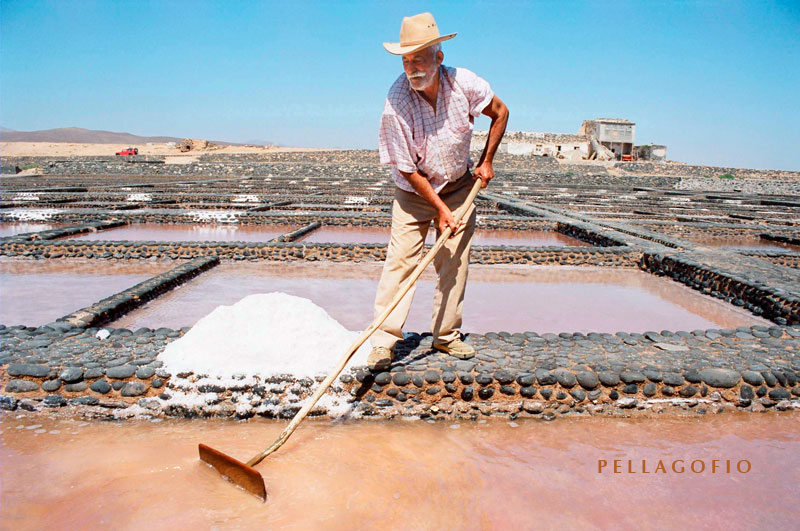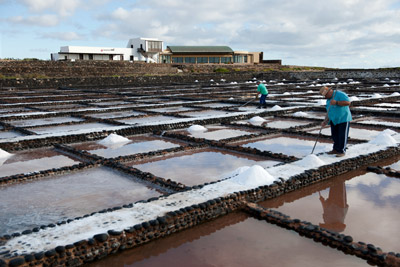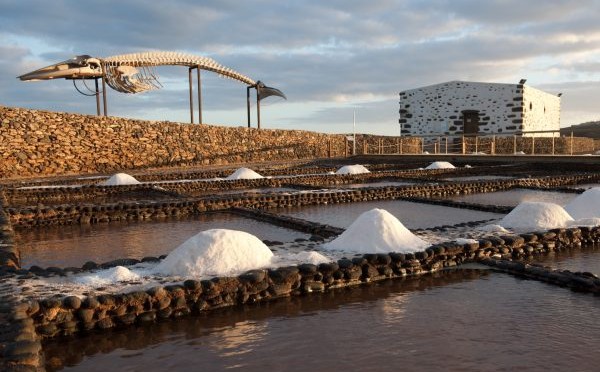Throughout history, a whole cultural and commercial world has developed around salt. In Fuerteventura, already since the times of the Mahos (ancient aboriginal inhabitants), salt was part of their culinary culture, using salt water to cook and preserve food.
It’s already at the time of the conquest by the Spanish lords (1402-1496) when this sea resource begins to be used and managed, thus developing the salt farming activity.
Between the sixteenth and eighteenth centuries a true salt industry was created in Fuerteventura , with different areas of operation. Although currently only Las Salinas del Carmen (Antigua) remains active, as from the nineteenth century industrial processes left craft aside, in ancient times there were farms in La Hondurilla (Caleta de Fuste), El Charco (Puerto del Rosario), Gran Tarajal and the island of Lobos in Marrajo area where, in our daily trips to the neighbouring island, the remains of these salt farming areas can still be observed. Today, thanks to the creation of the “Centro de Interpretación de la Sal” in Las Salinas del Carmen, the ancient craft of salt maker has been kept, and the visitor can discover how salt is produced on the island in the traditional way.
Salt marshes are characterised by two factors: - First, to produce salt on clay soils where, when water evaporates, the salt that is produced also acquires salts from the soil, so their nutritional values are much richer. - And second, because the sea water used in these salt marshes is surface water, which is the best. Generally, in other salt marshes, sea water is transported to the cookers through pipes using pumps, so it is water from the depths, but at Las Salinas del Carmen water directly gets into the salt marsh after breaking the waves, therefore, what comes in is actually lots of whipped foam, which produces a high quality salt: what is known as foam salt. So this foam salt from Fuerteventura is a premium product which is becoming a gourmet product in some markets such as Japan, and it is easier to find in fine dining restaurants. Numerous studies have shown the benefits of this salt foam in contrast to common salt.
Process Once the wave breaks and enters the salt marsh, it’s directed to the heaters, which are some areas where water is reserved for 8 to 10 days, to get heated. After these days, the salt maker takes it to the cookers or pits, where it remains another 15 or 20 days, and water evaporates in the sun, leading to the formation of salt crystals. During this period the salt maker should mix the piles of salt with a rake twice a day, at sunrise and sunset, so that the crystals that are formed on the surface go to the bottom and allow the formation of more crystals. This is what is known as salt skimming.

© pellagofio.es
Then salt piles in “balaches”, which are edges of cookers or pits, and there it remains piled for a week, and from there it goes to the warehouse to be packaged.

Generally the process of obtaining salt starts in March, and it often extends to October (some years even later, if the rainy seasons hasn’t started). The rest of the year the work of the salt maker is to keep the salt in perfect conditions, cleaning the pits in depth and building new ones for the next season.
We recommend a tour around Centro de Interpretación de la Sal de Las Salinas del Carmen, where visitors can discover all the ins and outs of this craftsmanship so related to the sea around us.
Hours: Tuesday to Saturday, 10am to 18pm.
FuerteCharter Team
